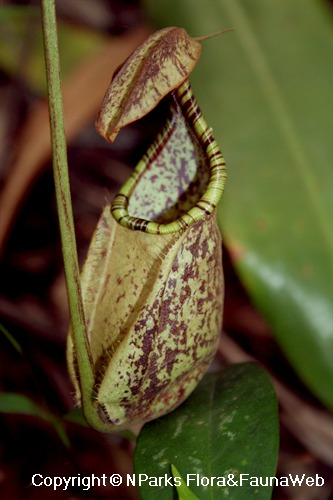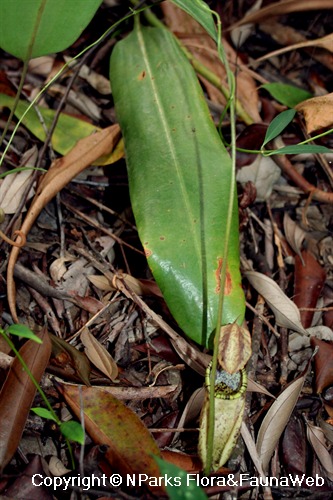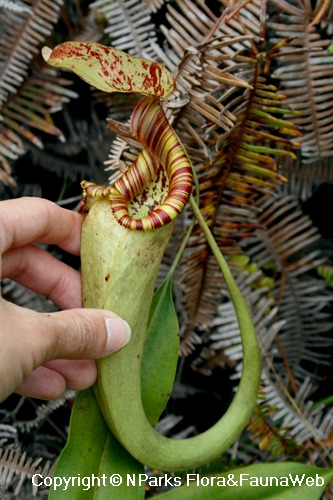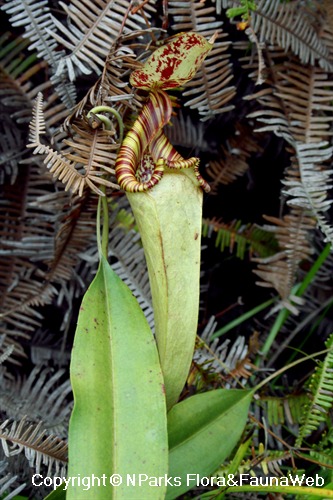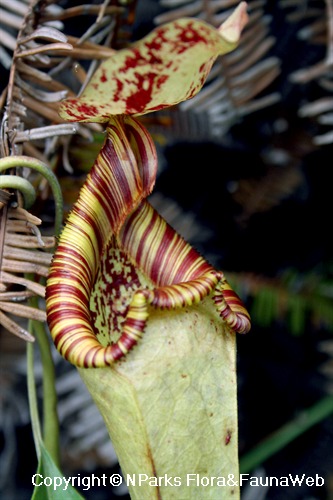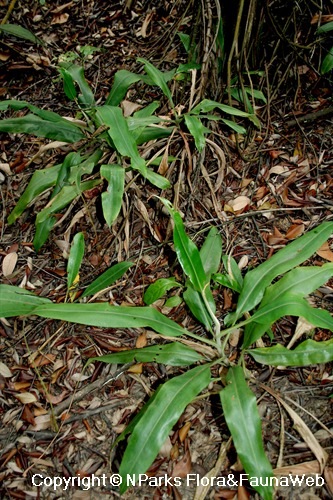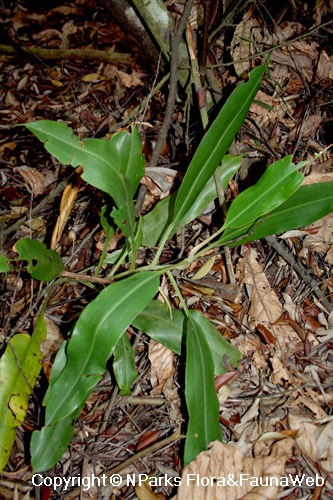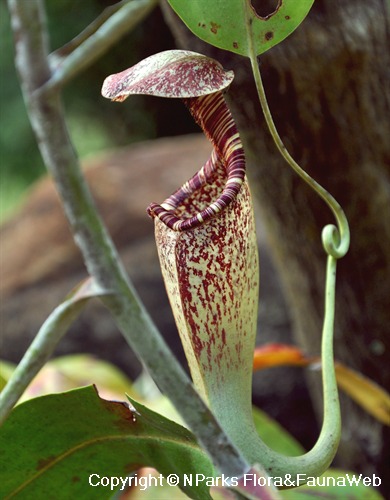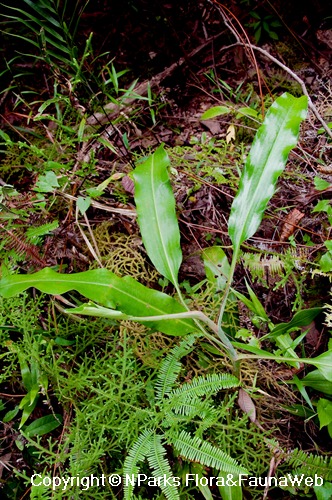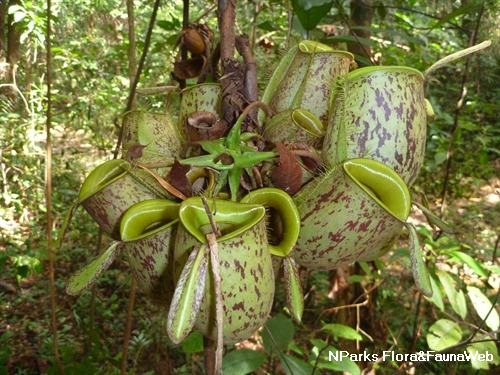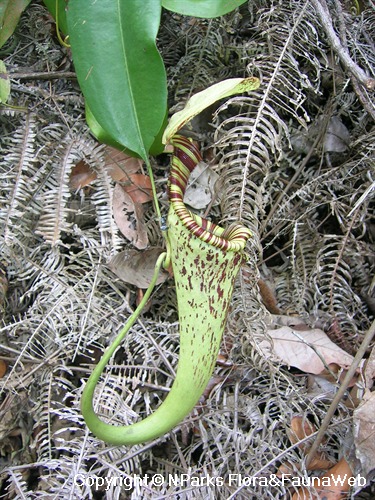
Back
Nepenthes rafflesiana Jack ex Hook. f.
| Family Name: | Nepenthaceae |
| Synonyms: | Nepenthes nigropurpurea, Nepenthes sanderiana, Nepenthes hemsleyana |
| Common Name: | Raffles' Pitcher Plant, Monkey Cup, Periok Kera, Periok Monyet, Periok Kerangga, 猪笼草 |
Name
Classifications and Characteristics
| Plant Division | Angiosperms (Flowering Seed Plants) (Dicotyledon) |
|---|---|
| Plant Growth Form | Climber |
| Lifespan (in Singapore) | Perennial, Semi-Annual / Annual-Like |
| Mode of Nutrition | Autotrophic |
| Plant Shape | Irregular |
| Maximum Height | 10 m to 15 m |
Biogeography
| Native Distribution | Peninsular Malaysia, Singapore, Borneo, Sumatra |
|---|---|
| Native Habitat | Terrestrial (Secondary Rainforest, Coastal Forest) |
| Preferred Climate Zone | Tropical |
| Local Conservation Status | Native to Singapore (Vulnerable (VU)) |
| CITES Protection | True (Appendix II) |
Description and Ethnobotany
| Growth Form | Herbaceous to semi-woody carnivorous vine, climbing to 15m high or more in height, with tendrils reaching over 1.1m in length. |
|---|---|
| Foliage | Leaves leathery, oblong, sessile (stalkless), 20-30cm long, glossy or dull green when mature, velvety reddish-brown when young. Leaf tips terminate in coiling tendrils, which under ideal conditions are modified into prey-catching pitchers, partially filled with rainwater enriched with digestive enzymes secreted by glands on waxy internal walls. |
| Flowers | Small, yellow, petal-less, clustered into erect raceme inflorescences up to 80cm long. Plant is diocecious, with male and female flowers found on separate plants. Blooming occurs once or twice per year, lasting for several weeks, pollinated by nocturnal flies and moths. When blooming period coincides with that of other Nepenthes species in the vicinity, hybridization may result. Natural hybrids in Singapore include: Nepenthes × hookeriana (= N. ampullaria × N. rafflesiana) and Nepenthes gracilis × N. rafflesiana. |
| Fruit | Clusters of explosive capsules, maturing from green to brown, with lightweight threadlike, wind-dispersed seeds. |
| Others - Plant Morphology | Local Conservation Status: Native, vulnerable, and threatened with habitat loss. International trade of plant controlled by CITES II listing. Largest, most spectacular and second most common amongst the 3 native Nepenthes species, found locally in Kent Ridge Park, Central Catchment Reserves and Western Catchment forests. Also one of the dominant species on coastal cliffs of Southern Islands, growing down to the tide line.Lower Pitchers: Large (up to 20cm tall by 7cm across), egg-shaped or shortly-cylindrical, with sparse to dense maroon blotches against green background, as well as tendril attachment and 2 hairy well-developed longitudinal wings on outer front wall. Peristomes (lips) colourful. strongly-ribbed with inward-facing teeth, and characteristically elongated into a "neck" below pitcher lid. Lids rhomboidal, act as shelter to prevent pitcher fluid from being diluted by rain. Pitcher colourations and sizes vary widely according to site. Giant forms found in Sabah produce lower pitchers up to 40cm tall by 15cm wide, which may contain the remains of larger prey like drowned mice. Upper Pitchers: Funnel-shaped, up to 30cm by 9cm, with tendril attachment at hind wall, usually green with sparse maroon speckles. Peristome equallly colourful and ribbed, with unusually-elevated wedge at the front.Discovery: Species was first discovered in Singapore in 1819 by Dr William Jack (1795 - 1822), Scottish botanist and surgeon with the East India Company, when he accompanied Raffles to the island. Jack's botanical discoveries in the Malesian region helped encourage the founding of the precursor to the Singapore Botanic Gardens in 1822, and he died from acute malaria in the same year at the age of 27, while out at sea near Sumatra. |
| Habitat | Tropical lowland peat swamp forests, secondary rainforests and other damp degraded areas with poor acidic soils, exposed cliff faces. |
| Associated Fauna | Species' diet typically insectivorous. Pitchers sometimes colonized by cannibalistic larvae of local mosquitoes (Toxorhynchites species) adapted to the pitcher's fluid, and which not only feed on the decomposing parts of pitcher victims, but also prey on fellow larvae co-exisiting within the same pitcher --- after which whose remains are digested by the plant. Also associated with the slow-moving Misumenops nepenthicola (Nepenthes Crab Spider), which lays its eggs on the internal pitcher walls, and ambushes insect prey that approach the pitchers. |
| Cultivation | Grows well under bright indirect sunlight, withstands full sun. Plants grown in deep shade tend to produce few or no pitchers. Prefers moist, poor-nutrient acidic media like peatmoss, sphagnum moss or salt-free cocopeat. Avoid fertilizing, especially with fast-release fertilizers, which may burn or kill the plant, or result in excessive foliage growth without pitcher formation. Scrambling plant can get very large and ungainly -- if desired, prune to control size. Propagate by seeds (variable progenies), or stem cuttings. If taking tip cuttings, use 4-node cuttings (tip plus 3 lower leaves) to prevent tender growing tip from rotting before establishment. Single-node cuttings from lower parts of the plant are also possible. |
| Etymology | Genus epithet 'Nepenthes' derived from Greek terms 'ne' (not) and 'penthos' (sorrow, grief), meaning 'no sorrow' or 'banished sorrow', as based on the ancient Greek name for an anti-depressant drug called 'Nepenthe' which drives away all sorrows by the means of forgetfulness, and used here in conjunction with the purported medicinal qualities of some Nepenthes species. Species epithet 'rafflesiana named in honour of British statesman and East India Company trader, Sir Thomas Stamford Raffles (1781-1826) -- best known for founding modern Singapore, and administering the newly set-up British colonies in the Southeast Asian region during the early 19th century. |
| Ethnobotanical Uses | Food (Herb or Spice) Others: Medicinal: Plant contains gylcosides and phenols. In Malaysia, roots boiled and made into poultice to treat stomachaches and dysentery. Stem decoction drunk to relieve fever and cough. Pitcher fluid reportedly used in Borneo to moisturize skin, soothe burns, treat eye inflammation, as well as laxatives. Products: Climbing stems sometimes used for ropes or woven handicrafts. Nepenthes expert Charles Clarke apparently commented that villagers in Brunei use the pitcher fluid as hair-styling gel, but this is quite unlikely because of the bad smell and presence of dead insects and biting ants. Pitchers reportedly used by Malay bomohs (shamans) in rites involving for spirit exorcisms and bringing of rain. Pitchers used in Philippines as vessels for drinking, cooking and transport of water. |
Landscaping Features
| Desirable Plant Features | Ornamental Foliage |
|---|---|
| Landscape Uses | Container Planting, Suitable for Hanging Baskets, Vertical Greenery / Green Wall, Focal Plant |
| Thematic Landscaping | Carnivorous Garden, Naturalistic Garden |
Fauna, Pollination and Dispersal
| Seed or Spore Dispersal | Abiotic (Explosive Dehiscence) |
|---|
Plant Care and Propagation
| Light Preference | Semi-Shade, Full Sun |
|---|---|
| Water Preference | Moderate Water |
| Plant Growth Rate | Slow |
| Rootzone Tolerance | Poor Infertile Soils, Waterlogged Soils (Drains Site), Acidic (low pH) Soils, Saline Soils / Salt Spray |
| Maintenance Requirements | Moderate |
| Propagation Method | Seed, Stem Cutting |
Foliar
| Foliage Retention | Evergreen |
|---|---|
| Mature Foliage Colour(s) | Green |
| Mature Foliage Texture(s) | Smooth, Leathery, Thick |
| Foliar Modification | Pitcher Trap |
| Foliar Type | Simple / Unifoliate |
| Foliar Arrangement Along Stem | Alternate |
| Foliar Shape(s) | Non-Palm Foliage (Lanceolate) |
| Foliar Venation | Pinnate / Net |
| Foliar Margin | Entire |
| Foliar Apex - Tip | Acute |
| Typical Foliar Area | Mesophyll ( 45cm2 - 182.25 cm2 ) |
| Prominent Young Flush Colour(s) Remarks | Velvety Reddish-Brown |
Non - Foliar and Storage
| Stem Type & Modification | Herbaceous |
|---|---|
| Root Type | Underground (Fibrous Root) |
Floral (Angiosperm)
| Flower & Plant Sexuality | Unisexual Flowers , Dioecious |
| Flower Colour(s) | Yellow / Golden |
|---|
| Inflorescence Type | Raceme |
| Flowering Period | Once Yearly |
| Flowering Habit | Polycarpic |
Fruit, Seed and Spore
| Mature Fruit Colour(s) | Brown |
|---|---|
| Fruit Classification | Simple Fruit |
| Fruit Type | Dehiscent Dry Fruit , Capsule |
Image Repository
Others
| Master ID | 163 |
|---|---|
| Species ID | 1459 |
| Flora Disclaimer | The information in this website has been compiled from reliable sources, such as reference works on medicinal plants. It is not a substitute for medical advice or treatment and NParks does not purport to provide any medical advice. Readers should always consult his/her physician before using or consuming a plant for medicinal purposes. |

